Wall-hung cabinet with sink: tips for choosing + analysis of installation technology
Making your bathroom beautiful, comfortable and functional is not so difficult if you pay more attention to the choice of plumbing fixtures and furniture.For example, a hanging cabinet with a sink can be an interesting highlight that will not only fit seamlessly into any design, but will also become a stylish decoration for the room.
A wide range of models allows you to choose this element of the interior to suit every taste and budget, and not too complicated installation and the presence of all the necessary fasteners make installation accessible to DIYers.
In this material we will talk about what hanging cabinets for bathrooms are, and what to look for when choosing. We will also tell you the subtleties of installing suspended structures.
The content of the article:
Types of suspended structures
The decision to decorate the bathroom with a wall-hung cabinet with a sink is not even half the battle, because you still have to choose the appropriate model, buy it and install it. Therefore, let's start from the beginning - find out what manufacturers offer, and try to decide which option is best suited for the bathroom.
Advantages of suspension systems
Those who have already encountered information about bathroom furniture know that there are several types of cabinets depending on the installation method.Of these, two types are floor-standing - standing on the floor with the bottom and legs, and hanging. Read more about bathroom cabinets Further.
So why are wall-hung sink cabinets in such high demand?
There are several reasons:
- Long service life. It is the suspension systems, due to the most optimal air circulation, that are less susceptible to the destructive effects of moisture and steam.
- Easy to install. There is no need to involve specialists for installation; if all the necessary elements and clear instructions are available, any home craftsman can handle the installation.
- Ease of maintenance. Easy access to the floor under the furniture allows not only to simplify the cleaning process, but also to notice in time and, therefore, eliminate leaks.
- Saving space. This quality should not be confused with the purely visual effect of increasing the size of the room, although this is one hundred percent present. You can verify in practice that even a small-looking cabinet can accommodate a lot of necessary things, which until then were randomly dispersed throughout the room.
- Individual approach. Even if your height or build is not much beyond the standard, the ability to install the sink at a height that is comfortable for you makes life much easier.
- Aesthetic functionality. The hanging cabinet is not only conveniently organized for storing a variety of small items needed in the bathroom. It also hides behind its own facade all the unsightly-looking plumbing stuffing.
- Extensive selection of design solutions. It is quite possible to choose furniture to suit any style and interior or to offset the heaviness of the washbasin with the airy design of the hanging cabinet.
Many, having seen a solid list of advantages, will immediately think - do hanging cabinets really have no disadvantages? Alas, there is no ideal. A significant disadvantage of the design is the requirement for truly reliable support.
Brick or reinforced concrete walls are best suited for this, but for plasterboard panels you will have to lay a reinforced frame in the places where the cabinet with sink is attached to them.
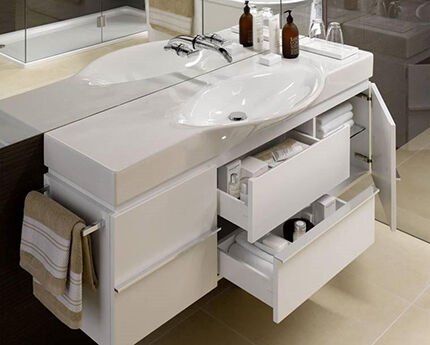
And one more thing - wall models really look good only if all communications are hidden. When the sewer pipe remains in plain sight, for example, located along the entire wall above the floor, then hanging an elegant wall cabinet is the same as covering an old sideboard with a lace napkin.
Variety of classifications of hanging compositions
As mentioned above, there are many options for hanging models on the market. And our task at the moment is not just to choose an original design, but to try to take into account all the nuances - both design and operational. So what varieties are there now and what benefits do they provide?
Depending on the characteristics, we have several classification criteria:
- By size. Large or long hanging cabinets (for one or two sinks) most often attract owners of spacious bathrooms. Moreover, there are simply luxurious examples of this type of furniture, which would not be a shame to install in a palace. But mini-bedside tables will fit perfectly into small or frankly small bathrooms. But compact designs also delight with their design diversity and spaciousness.
- By location. Straight wall cabinets are suitable for any bathroom. Although they are considered standard, even here you can choose completely original models. The opposite option is considered to be corner structures. Their advantage is the so-called “expansion of space”, when, with a visible minimum size, a decent amount of usable space is hidden inside.
- By internal functionality. The configuration options differ in the presence, size and number of drawers, laundry baskets, towel holders and shelves behind the doors. And in order for the furniture to meet ergonomic requirements, the type of internal sections should be chosen taking into account the assortment that you are going to hide behind the facade of the cabinet.
However, all the considered variations should be attributed for the most part to the external, or even more likely to the interior, appearance.
But there are also important functional nuances by which the design of a cabinet and washbasin is classified.
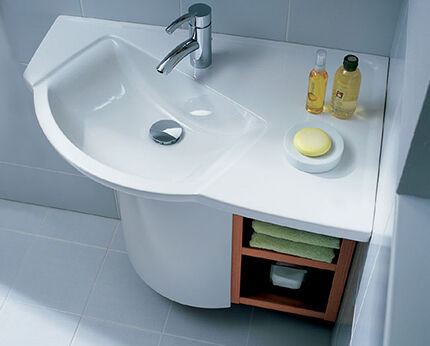
And now more about the cabinets.
Wall mounted sink cabinet
The simplest option seems to be “separate cabinet - separate sink”. That is, first it is taken wall mounted washbasin (in some cases you can even use an existing one), and only then select the appropriate piece of furniture to match it.
But despite the visible advantages of this composition, such as saving money, the ability to increase the choice of components or avoid unnecessary work, there are also significant disadvantages:
- Firstly, in any case, it is necessary to change the old sink and its communications. For a deep, massive structure from the times of the Soviet Union with a large siphon and connecting pipes located further from the wall, the furniture will be only a front box, acting as a disguise for plumbing nuances. There is not much useful space left in such a cabinet.
- Secondly, most often a cabinet purchased separately has to be “finished with a file”, cutting out various kinds of holes in the countertop, shelves (drawers) and other interfering parts for both the sink itself and its plumbing parts.
- Third, all newly formed ends after sawing must be protected from the harmful effects of the bathroom atmosphere. And for this you will have to either glue melamine edges or lay silicone seals.
That is, you will not only not make your life easier, but you will also be forced to do extra work.

True, for real masters, additional work is not an obstacle, and they are able to make a masterpiece even from a conditionally suitable material.
Design with built-in sink
This type of suspension system differs from the previous one only in the presence of structural elements already adjusted to each other.
There is an option when the sides of the sink protrude above the plane of the countertop, are flush with it, or are recessed under the lid.
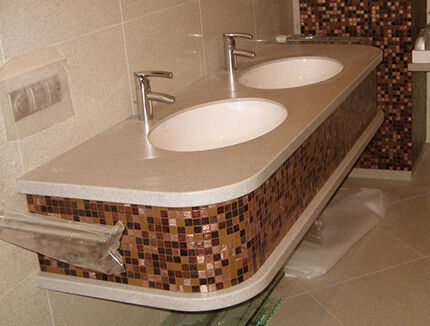
A very convenient variety, as it allows you to use not only the internal volume of the cabinet, but also its upper part. When installing such a composition, you need to take care of the tightness of the “countertop-sink” joint to prevent moisture from getting inside.
Wall-hung system with washbasin-countertop
A simpler version of a built-in washbasin. Exclusively because the sink itself, which has additional wide sides, is used as a countertop.
This model retains all the advantages of the previous type with a pleasant bonus - there is no need for additional work on sealing joints.
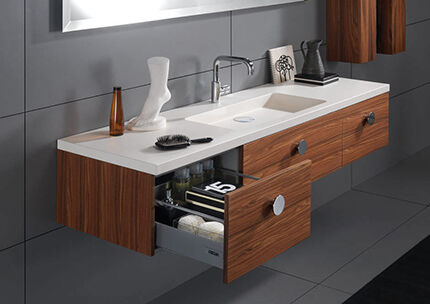
Wall-mounted vanity with countertop washbasin
A special composition for sophisticated people – when the washbasin is installed directly on the surface of the cabinet lid.
Externally, the model looks very elegant and stylish, especially if glass sink. And the installation process of such a suspension system is much simpler. Not to mention the much more complete use of the cabinet's interior space.

Suspension system materials and their combinations
In addition to the design and construction characteristics of wall-hung cabinets with a sink, in the selection process it is also worth considering the materials from which the elements of the composition are made.
What are shells made of?
The main options for sinks are most often the following materials:
- Ceramics (porcelain or glazed earthenware). They are of good quality, but require care during installation and use, as they have significant weight and are relatively fragile.
- Stone (natural or artificial). Excellent performance, but even heavier than ceramics. Go to linkto find out more.
- Glass. They look very impressive, especially when using a colored or matte variety with backlighting. Despite the fragility of the material, it is quite difficult to break such a sink, but it is quite possible to scratch it if not properly cared for.
- Metal (stainless steel, copper, bronze or brass). It is quite rarely used in the bathroom, but for some interior styles, for example, “antique” retro or urban high-tech, it is very popular. Like glass, it requires careful care.
- Plastic (acrylic). The most short-lived material, although here everything depends on the quality - expensive acrylic sinks can last quite a long time, but cheap options will last only a couple of years, no matter how much you take care of them.
This variety allows you to choose a washbasin not only by appearance and quality, but also by price.
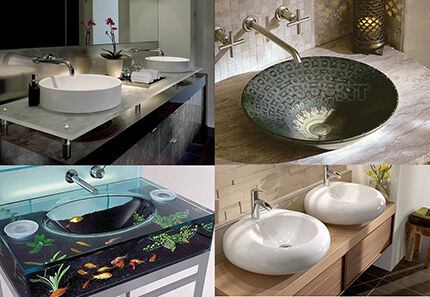
Wood is also used as a material for plumbing fixtures, but only specially treated with moisture-proofing agents.
Material for making hanging cabinets
As with the sink, a variety of materials are used to make vanities.
- laminated chipboard. Laminated chipboard has proven itself well in the production of furniture, but for the bathroom it is used only in the most budget-friendly options. The fact is that, despite the protective coating, moisture still penetrates into the slab itself, which is why it swells and delaminates over time.
- MDF. These specially impregnated boards are more moisture-resistant, and if they are painted or hermetically sealed with a plastic coating, the durability of furniture made from this material is essential even for the atmosphere of the bathroom. And the prices of the models are very reasonable.
- Tree. This is already an elite option, since wood, which is not only moisture-resistant, but also strengthened under the influence of moisture, is expensive in itself. Therefore, it is most often used for individual “manual” work.
- Metal. Stainless alloys are much more reliable than wood boards, but products made from them are not suitable for every interior.
- Stone. A heavy and reliable option, also classified as an elite one.
- Glass. A modern and increasingly popular material for making furniture. Gives the entire interior lightness and airiness and can be used in a variety of forms. The only negative is that it requires caution when using and careful maintenance, because even on frosted glass any drips and water stains are clearly visible.
Despite the fairly wide choice, cabinets made of MDF and glass are in greatest demand among the majority of the population.
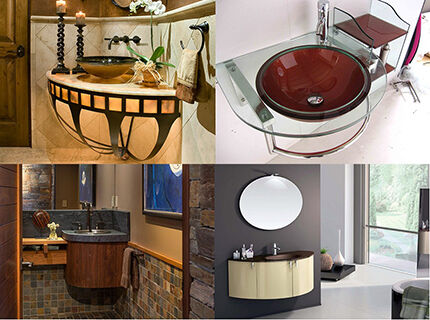
When choosing a complete set of washbasin and cabinet, pay attention to how harmoniously such a set looks. At the same time, take into account the rest of the bathroom furnishings.
Fittings – which material is better?
In addition to the main elements of hanging systems - cabinets and sinks, there are also additional ones - fastening and decorative parts. And the appearance and durability of the entire structure as a whole also depend on their quality.
Experts advise choosing fittings made of chromed metal, since plastic or gold-plated products last much less.
Calculation of cabinet dimensions
To select the ideal wall-hung cabinet, determining where to install the washbasin is a prerequisite. And here we have two options - install the new thing in the same place where the old sink stood, or find a more convenient location. At the same time, it is necessary to take into account the comfort of use for all family members.
What should you pay attention to?
- The most prudent owners use the oldest system - a practical approach. Each of the residents in the selected place should try it on, performing the usual actions when washing. For a more complete effect, you can place a stool with a basin there. Thanks to this home “test,” it immediately becomes clear how convenient it is to use the sink, and whether walls, pipes, the bathroom or other objects will interfere.
- After the final decision, the washbasin will be located right here! – the horizontal dimensions of the free space are taken, taking into account all interfering communications. It is these that will limit the dimensions of the structure.
- Finally, we determine the most convenient installation height. Following the recommendations of SNiPs, we set the standard distance from the side of the washbasin to the floor within 80-85 cm. But according to anthropological research, a comfortable sink is located 7-8 cm below the bend of the elbow.
- At the same time, it’s worth thinking about the vertical dimensions of the cabinet and the use of free space under it. For example, some will prefer a small bedside table to place a washing machine, a laundry basket or a small pull-out step for a child below.
If you take into account all the proposed criteria, the choice will be difficult, but correct.
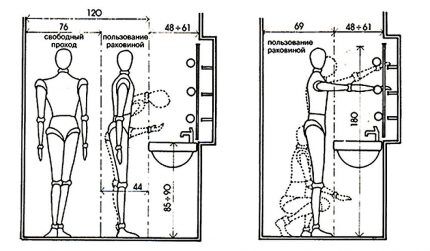
And after purchasing a system that is suitable from all sides, you can begin its installation. We also recommend reading our other article, which provides tips on choosing sinks of suitable size For bathroom.
Suspension system installation technology
Instructions for installing a wall-hung cabinet with a sink are usually included with the purchased kit along with all fasteners. And although they differ for each specific variety, it is still possible to identify general points that are suitable for any design.
There are no universal instructions for installing a hanging cabinet with a sanitary sink, since all models have individual design features.However, literally any technology has common features. As an illustrative example, consider one of them:
The preparatory stages of work have been completed. The sink is suspended and connected to the sewer outlet. Now you need to install and secure the hanging cabinet:
The first step when installing any model of suspended structure is to make sure that the water supply and sewer outlets are located exactly where needed. That is, even when determining the installation location, take care of their installation. And only after this should one begin “artistic” work, that is, drawing markings on the wall along which the fastening will be carried out.
Be sure to check all lines for evenness using a building level, since drawing “by eye” can lead to unpleasant distortions. It is most convenient to do this with an assistant, then one person holds the sink or cabinet frame against the wall with a level placed on top, and the other, with a marker or pencil, marks the points of future fastenings directly in the holes intended for this.
The next stage is drilling. If you bought a set with a wall-mounted sink, then first drill holes for anchor hooks or studs for fastening.
After this, we prepare the openings for the dowels for the cabinet itself. A small nuance - when working with ceramic tiles in the marked places, carefully use a chipper to make small indentations so that the drill does not slip at the beginning of rotation. And remember, for strong walls (brick or slag concrete) it is better to use Pobedit drills.
Insert dowels or anchors into the holes made.We install and secure the sink, tightening the nuts with a regular wrench (it is best to use an open-end wrench). We assemble and connect the siphon and mixer, acting strictly according to the instructions included with the kit. Be sure to install all the necessary gaskets.
We check the tightness of the connections. To do this, run water into the sink and leave it for about 10-20 minutes. We lay sheets of paper under the sink in the area where the water and sewer pipes exit. If after the allotted time the paper remains dry, it means the connection was made correctly. Otherwise, you will have to fix the leak.
We install the cabinet in place, having first removed all internal elements such as drawers from it. We check the correct installation using a building level placed on the bottom of the cabinet.
We pay special attention to the joints between the sink and the wall, and the sink and the cabinet. Experienced craftsmen advise using a regular door (or window) elastic seal for such places. It perfectly seals cracks, lasts much longer without losing its properties, unlike silicone sealants.
We insert all the removed parts into the cabinet, leveling any possible distortions. All is ready. We carefully inspect the installed system and rejoice at the new thing.
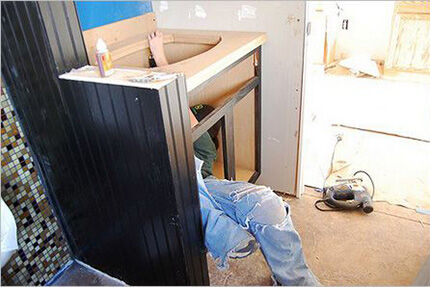
It seems that the scheme is not too complicated, the main thing in this work is accuracy and precise execution of the attached instructions.
Conclusions and useful video on the topic
You can see some types of hanging cabinets of various designs in this video, which will allow you to go to the store with more confidence:
An example of instructions for installing a wall-hung cabinet with a wall-mounted countertop sink:
Here you can evaluate the work of professionals who install a custom wall-hung structure with a countertop washbasin:
As you can see, choosing a suitable wall-hung structure with a washbasin is much more difficult than installing it in the bathroom. And if you handled this task correctly, then installation will be up to you.
But if you have doubts about your own technical skills, you can always turn to professionals who will assemble and connect everything with high quality. This treatment is especially appropriate if you are purchasing a really expensive model.
Perhaps after reading our article you have questions - ask them in the comments section, and we will try to answer them promptly. Or maybe you had to install a suspended structure in the bathroom yourself and you know the subtleties that we did not mention? Please share your editing secrets with our readers.




We don't have a cabinet in our bathroom; everything is stored on hanging shelves. These shelves collect a lot of dust and take a long time to clean. You'll be tortured while you wipe down every bottle and the shelf itself. And everything is in plain sight. I really liked the idea of replacing all this with a hanging cabinet; there is just room under the sink. There will be less work and a more aesthetic appearance. My husband is handy and can do everything himself, including the cabinet itself. True, he will grumble a little that I found him a job again. By the way, the design can be copied from the photos posted here.
I also replaced the open shelves with a similar wall-mounted vanity unit. It’s really more convenient and neater when there are no different bottles in sight. But why fool yourself and do it yourself. I bought it at the store. Now there is such a huge choice. Different shapes and designs. I have this cabinet made of materials that are not afraid of moisture - plastic, glass. You can't do that yourself.
Taking into account our small-sized bathrooms, a bathroom cabinet is of course necessary for rational use of space. But I don’t think that a suspended one is needed.
In addition, more will fit in the floor one - after all, you can put something else down. So I would still think about whether the game is worth the candle. The advantages of hanging furniture are not so obvious as to categorically declare its advantages.